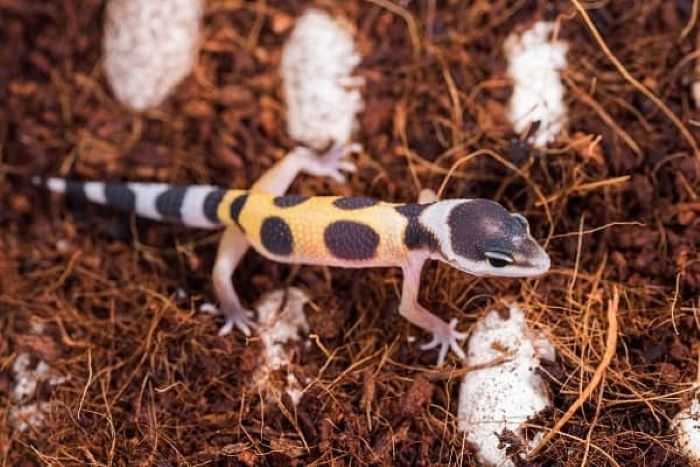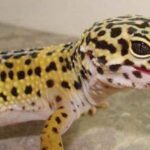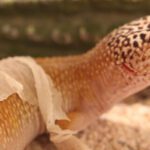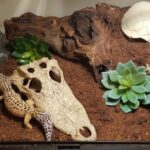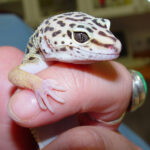Leopard geckos are popular pets due to their manageable size, docile nature, and unique appearance. However, when selecting a baby Leopard gecko, it’s crucial to ensure it’s healthy and well-adjusted. Recognizing signs of a healthy gecko early on can prevent long-term health issues and make caring for your pet more rewarding.
In this guide, we will discuss essential traits of a healthy baby Leopard gecko and tips on what to look for when selecting one.
Table of Contents
Introduction to a Healthy Baby Leopard Gecko
Choosing a healthy Leopard gecko means observing physical characteristics, behavior, and overall condition. Leopard geckos, like many reptiles, may not always display obvious signs of illness, so knowing what to look for in a healthy individual is key. Here are some common traits to check that indicate good health.
Observing Physical Characteristics and Behavior
Leopard geckos are naturally nocturnal, and this affects how they respond to their environment. Their reaction to movement, posture, eating habits, and body condition all offer clues about their health status. Below are detailed signs to assess when choosing a healthy baby gecko.
Alert Attitude
A healthy baby Leopard gecko should display an alert attitude, especially at night when they are most active. These little reptiles are naturally curious and should show interest in their surroundings. When there’s movement around, the gecko should respond by turning its head or shifting its body to observe. This alertness indicates a well-functioning nervous system and reflects the gecko’s general well-being.
Willingness to Eat
A baby Leopard gecko’s willingness to eat is one of the most telling signs of good health. They should exhibit interest in their food, especially if it’s moving, as this stimulates their natural predatory instincts. If offered prey such as crickets or mealworms, a healthy gecko will approach and may even actively hunt the food. Any noticeable lack of appetite may signal stress, illness, or other health issues.
Clear Eyes, Nose, and Mouth
The eyes, nose, and mouth of a healthy baby Leopard gecko should be clean and free from any discharge. There should be no crusts, sores, or dirt around these areas. Clear eyes without any cloudiness or discharge are particularly important, as issues with these can indicate respiratory infections or eye problems, which are common health issues in geckos.
Clean and Dry Vent Area
The vent, or cloacal area, should be clean and dry. Any dirt or discharge here might suggest digestive problems, possibly diarrhea, which can indicate poor diet or an underlying health issue. Ensuring this area is well-maintained is essential for overall health.
Examining Physical Condition and Posture
Healthy geckos exhibit a certain physical form and posture that speaks to their muscular and skeletal health. Observing how they stand and move is a straightforward way to assess health.
Upright Posture
Healthy Leopard geckos should have an upright posture, with their body and limbs held at a natural angle. This posture shows that they have good muscle and bone health, essential for movement and general activity. A gecko that appears lethargic or has difficulty standing may have issues related to muscle tone or metabolic bone disease (MBD), a condition caused by insufficient calcium intake.
Filled Out Belly
A well-fed baby Leopard gecko typically has a slightly rounded belly, indicating that it’s receiving adequate nutrition. A gecko with a thin or sunken abdomen might not be eating properly or could be suffering from internal parasites. Checking for a full, healthy belly is an easy way to gauge if the gecko has been eating well and is digesting food correctly.
Absence of Swellings in Toes and Tail
The toes and tail of a healthy Leopard gecko should be free from any swellings. Swollen toes can indicate shedding problems, a common issue for geckos that don’t have adequate humidity in their environment. Swelling in the tail could signal internal issues or even trauma. Checking these areas can prevent future complications and ensure a smooth shedding process.
Further Indicators of Health in Baby Leopard Geckos
In addition to the core signs listed above, there are other aspects of a Leopard gecko’s appearance and behavior that can help determine its health.
Healthy Skin Shedding Process
Leopard geckos shed their skin periodically, and a healthy gecko should have a smooth shedding process. Signs of incomplete shedding, such as retained skin on the toes or around the eyes, can lead to more serious issues like restricted blood flow. Monitoring the shedding process can help ensure that the gecko has a balanced environment with appropriate humidity levels.
Healthy Bone and Muscle Structure
Leopard geckos require calcium for strong bones and muscles. Without sufficient calcium, they risk developing metabolic bone disease, which can lead to fragile bones and abnormal body structures. To check for a healthy bone structure, observe their posture and movement, ensuring that they can move easily and support themselves without difficulty.
Vibrant and Clear Skin
The skin of a healthy Leopard gecko should appear smooth, vibrant, and free of any discoloration or bumps. Skin that appears dull, patchy, or bumpy could indicate a fungal infection or skin condition. Regular inspection of their skin is a proactive way to catch any issues early.
Behavioral Indicators of a Healthy Baby Leopard Gecko
Behavior is another vital aspect when assessing the health of your Leopard gecko. Not only should they respond to food and movement, but they should also display certain natural behaviors that indicate comfort and well-being.
Curiosity and Exploration
A healthy baby Leopard gecko should show curiosity about its environment, especially during active hours. It may explore the enclosure, check out new objects, and investigate its surroundings. This behavior reflects both physical and mental well-being.
Lack of Aggression or Stress
Leopard geckos are generally docile and calm. Signs of aggression or stress, such as tail waving, open-mouthed hissing, or biting, could indicate discomfort or health issues. Ensuring that the gecko feels safe and comfortable in its environment is essential for maintaining its health.
Essential Care Tips for Maintaining a Healthy Baby Leopard Gecko
After selecting a healthy baby Leopard gecko, ongoing care is crucial to keeping it that way. Here are some essential tips to ensure a thriving pet:
Providing a Balanced Diet
A varied diet is key to keeping Leopard geckos healthy. Their diet should include live insects like crickets, mealworms, and occasional waxworms, dusted with calcium powder to support bone health. Gut-loading insects with nutritious foods before feeding them to your gecko ensures that it receives essential vitamins and minerals.
Proper Habitat Setup
Setting up a comfortable and safe habitat is fundamental to your Leopard gecko’s health. Include hiding spots, appropriate substrate, and maintain ideal temperature and humidity levels. Leopard geckos need a temperature gradient in their enclosure, with a warm basking area and a cooler side for thermoregulation.
Regular Health Check-Ups
Regularly inspecting your gecko for any signs of illness, abnormal behavior, or physical changes is important. Observing daily activities like eating, drinking, and shedding can help catch issues early and allow for timely treatment.
Final Thoughts on Selecting and Caring for a Baby Leopard Gecko
Owning a Leopard gecko is a rewarding experience, but it requires commitment to provide proper care and attention. By knowing what to look for in a healthy baby gecko and maintaining a well-balanced diet and safe habitat, you can ensure that your pet remains healthy and happy for years to come. Keeping these tips in mind will help you make informed decisions when selecting and caring for your Leopard gecko.

